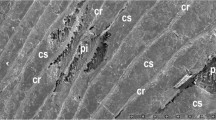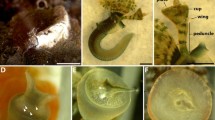Abstract
The calcareous operculum of Pyrgopolon ctenactis is composed of spherulitic prismatic structures. The opercular cup consists of regular spherulitic prismatic crystals; the talon has two layers, an inner with an irregular spherulitic prismatic structure (150 μm thick) and an outer with a regular spherulitic prismatic structure (110 μm thick). The outer regular structure has thick (1 μm) organic interprismatic sheets unique in biomineralization of this group, but similar to that of Bivalvia. We infer that control over biomineralization is stronger during the formation of the outer regular layer, with its thick organic interprismatic sheets, than during the formation of the inner irregular spherulitic prismatic structure, without such sheets. In Spirobranchus giganteus, opercular formation differs from that of P. ctenactis. S. giganteus has numerous pores in its opercular plate, and calcification starts with the formation of an outer irregularly oriented prismatic structure followed by an oriented prismatic structure without interprismatic sheets.





Similar content being viewed by others
References
Bubel A (1976) Electron microscope studies on the operculum of Spirorbis spirorbis (L.). In: Sharpley JM, Kaplan AM (eds) Proceedings of the international biodegradation symposium no. 3. Applied Science Publishers, London, pp 495–514
Bubel A (1983) A fine structural study of the calcareous opercular plate and associated cells in a polychaete annelid. Tissue Cell 15:457–476
Bubel A, Thorp CH, Fitzsimmons CAL (1977) An histological and electron microscopical study of opercular regeneration in the serpulid, Pileolaria (P.) granulata, with particular reference to the formation of the calcareous opercular plate. In: Romanovsky V (ed) Proceedings of the 4th international congress on marine corrosion and fouling, Juan-les-Pins, Antibes, pp 85–96
Bubel A, Thorp CH, Moore MN (1980) An histological, histochemical and ultrastructural study of the operculum of the serpulid Pomatoceros triqueter L. with particular reference to the formation of the calcareous opercular plate during opercular regeneration. In: Oxley TA, Allsopp DA, Becker G (eds) Proceedings of the international biodegradation symposium no. 4, pp 275–290
Bubel A, Thorp CH, Fenn RH, Livingstone D (1985) Opercular regeneration in Pomatoceros lamarckii Quatrefages (Polychaeta: Serpulidae). Differentation of the operculum and deposition of the calcareous opercular plate. J Zool Lond Ser B 1:49–94
Carter JG, Bandel K, de Buffrènil V, Carlson SJ, Castanet J, Crenshaw MA, Dalingwater JE, Francillion-Vieillot H, Géradie J, Meunier FJ, Mutvei H, de Riqlès A, Sire JY, Smith AB, Wendt J, Williams A, Zylberberg L (1990) Glossary of skeletal biomineralization. In: Carter JG (ed) Skeletal biomineralization: patterns, processes and evolutionary trends, vol 1. Van Nostrand Reinhold, NY, pp 609–671
Cupedo F (1980a) De opercula van Hamulus sexcarinatus goldfuss (Polychaeta sedentaria, Serpulidae) uit het Boven-Krijt van Zuid-Limburg. Publ Nat Gen Limburg 29(2):1–7
Cupedo F (1980b) De opercula van Sclerostyla mellevillei (Nyst et le Hon), “Serpula” instabilis (Wrigley) en “Ditrupa” mosae (Bronn), en hun betekenis voor de systematiek van deze soorten. Publ Nat Gen Limburg 29(3):1–19
Deshayes GP (1826) Anatomie et monographie du genre Dentale. Mém Soc Hist Nat Paris 2:321–378
Fauvel P (1927) Polychètes sédentaires. Addenda aux errantes, Archiannélides, Myzostomaires. Faune de France, vol 16, p 494
Jäger M (2004) Serpulidae und Spirorbidae (Polychaeta sedentaria) aus Campan und Maastricht von Norddeutschland, den Niederlanden, Belgien und angrenzenden Gebieten. Geol Jahrbuch A 157:121–157
Linnaeus C (1758) Tomus I. Systema naturae per regna tria naturae, secundum classes, ordines, genera, species, cum characteribus, differentiis, synonymis, locis. Editio decima, reformata. Holmiae. (Laurentii Salvii), p 824
Lommerzheim A (1979) Monographische Bearbeitung der Serpulidae (Polychaeta sedentaria) aus dem Cenoman (Oberkreide) am Südwestrand des Münsterländer Beckens. Decheniana 132:110–195
Mörch OAL (1863) Revisio critica Serpulidarum. Et bidrag til rørormenes naturhistorie. Naturhistorisk Tidsskrift Henrik Krøyer. København ser 3 1:347–470
Nyst P-H, Le Hon H (1862) Description succincte de quelques nouvelles espèces animales et végétales fossiles des terrains tertiaires éocènes de Bruxelles. Bull Acad Roy Sci Lett Beaux-arts Belg Bruxelles
Pillai TG (2009) Descriptions of new serpulid polychaetes from the Kimberleys of Australia and discussion of Australian and Indo-West Pacific species of Spirobranchus and superficially similar taxa. Rec Aust Mus 61:93–199
Radwańska U (1994) A new group of microfossils: middle Miocene (Badenian) opercular caps (calottae) of the tube-dwelling polychaetes Vermiliopsis Saint-Joseph, 1894. Acta Geol Pol 44:84–96
Rioja E (1923) Estudio systematico de las especies ibéricas del suborden Sabelliformia. Trabajos del Museo nacional de Ciencias Naturales de Madrid (Zool) 48:1–144
Rovereto G (1904) Studi monographici sugli Annelidi fossili. I Terziario. Pal Ital 10:1–73
Sanfilippo R (1996) Micromorphology, microstructure and functional morphology of the Josephella marenzelleri (Polychaeta Serpulidae) tube. In: Cherchi A (ed) Autoecology of selected organisms: achievements and problems. Boll Soc Paleont Ital Spec 3:205–211
Sanfilippo R (1998) Tube morphology and structure of the bathyal Mediterranean serpulid Hyalopomatus variorugosus Ben-Eliahu and Fiege, 1996 (Annelida, Polychaeta). Riv Ital Paleont Strat 104:131–138
Sanfilippo R (2009) New species of Hyalopomatus Marenzeller, 1878 (Annelida, Polychaeta, Serpulidae) from Recent Mediterranean deep-water coral mounds and comments on some congeners. Zoosystema 31:147–161
Sanfilippo R, Mòllica E (2000) Serpula cavernicola Fassari and Mòllica, 1991 (Annelida Polychaeta): diagnostic features of the tubes and new Mediterranean records. Marine Life 10:27–32
Schöne BR, Dunca E, Fiebig J, Pfeifer M (2005) Mutvei’s solution: an ideal agent for resolving micro growth structures of biogenic carbonates. Paleogeogr Paleoclim Paleoecol 228:149–166
Tanur AE, Gunari N, Sullan RMA, Kavanagh CJ, Walker GC (2010) Insights into the composition, morphology, and formation of the calcareous shell of the serpulid Hydroides dianthus. J Struct Biol 169:145–160
ten Hove HA (1970) Serpulinae (Polychaeta) from the Caribbean: I. The genus Spirobranchus. Stud Fauna Curaçao Carib Isl 32:1–57
ten Hove HA (1973) Serpulinae (Polychaeta) from the Caribbean: II. The genus Sclerostyla. Stud Fauna Curaçao Carib Isl 43:1–21
ten Hove HA, Kupriyanova EK (2009) Taxonomy of Serpulidae (Annelida, Polychaeta): the state of affairs. Zootaxa 2036:1–126
ten Hove HA, Nishi E (1996) A redescription of the Indo-West Pacific Spirobranchus corrugatus Straughan, 1967 (Serpulidae, Polychaeta), and an alternative hypothesis on the nature of a group of middle Miocene microfossils from Poland. Beaufortia 46:83–96
ten Hove HA, van den Hurk P (1993) A review of recent and fossil serpulid “reefs”; actuopaleontology and the ‘upper malm’ serpulid limestones in NW Germany. Geol Mijnb 72:23–67
ten Hove HA, Zibrowius H (1986) Laminatubus alvini gen. et sp.n. and Protis hydrothermica sp.n. (Polychaeta, Serpulidae) from the bathyal hydrothermal vent communities in the eastern Pacific. Zool Scr 15:21–31
Vinn O (2007) Taxonomic implications and fossilization of tube ultrastructure of some Cenozoic serpulids (Annelida, Polychaeta) from Europe. Neues Jahrbuch für Geologie und Paläontologie, Abhandlungen 244:115–128
Vinn O (2011) The role of an internal organic tube lining in the biomineralization of serpulid tubes. Carnets de Géologie CG2011_L01
Vinn O, Mutvei H (2009) Calcareous tubeworms of the phanerozoic. Est J Earth Sci 58:286–296
Vinn O, Hove HA, ten Mutvei H (2008a) On the tube ultrastructure and origin of calcification in sabellids (Annelida, Polychaeta). Palaeontology 51:295–301
Vinn O, ten Hove HA, Mutvei H, Kirsimäe K (2008b) Ultrastructure and mineral composition of serpulid tubes (Polychaeta, Annelida). Zool J Linn Soc 154:633–650
Vinn O, Mutvei H, ten Hove HA, Kirsimäe K (2008c) Unique Mg-calcite skeletal ultrastructure in the tube of the serpulid polychaete Ditrupa. Neues Jahrbuch für Geologie und Paläontologie, Abhandlungen 248:79–89
Vinn O, Kirsimäe K, ten Hove HA (2009) Tube ultrastructure of Pomatoceros americanus (Polychaeta, Serpulidae): implications for the tube formation of serpulids. Est J Earth Sci 58:148–152
Wrigley A (1951) Some Eocene serpulids. Proc Geol Assoc 62:177–202
Zibrowius H (1973) Revision of some Serpulidae (Annelida Polychaeta) from abyssal depths in the Atlantic and Pacific, collected by the “challenger” and prince of Monaco expeditions. Bull Br Mus Nat Hist Zool 24(9):427–439
Zibrowius H, ten Hove HA (1987) Neovermilia falcigera (Roule, 1898), a deep-and cold-water serpulid polychaete common in the Mediterranean plio-pleistocene. Bull Biol Soc Wash 7:259–271
Acknowledgments
We are grateful to H. Mutvei (Swedish Museum of Natural History) and Mrs. E. J. Beglinger (ZMA) for assistance with SEM. This work was supported by the European Commission’s FPVI European-funded Integrated Infrastructure Initiative to the projects SYNTHESYS, NL-TAF-111 and SE-TAF-113 and by a Sepkoski Grant from Paleontological Society. O. V. indebted to the target financed project (from the Estonian Ministry of Education and Science) SF0180051s08 (Ordovician and Silurian climate changes, as documented from the biotic changes and depositional environments in the Baltoscandian Palaeobasin) for financial support. We thank editor and two anonymous reviewers for their critical but constructive remarks.
Author information
Authors and Affiliations
Corresponding author
Additional information
Communicated by G. Purschke.
Rights and permissions
About this article
Cite this article
Vinn, O., ten Hove, H.A. Microstructure and formation of the calcareous operculum in Pyrgopolon ctenactis and Spirobranchus giganteus (Annelida, Serpulidae). Zoomorphology 130, 181–188 (2011). https://doi.org/10.1007/s00435-011-0133-0
Received:
Revised:
Accepted:
Published:
Issue Date:
DOI: https://doi.org/10.1007/s00435-011-0133-0




